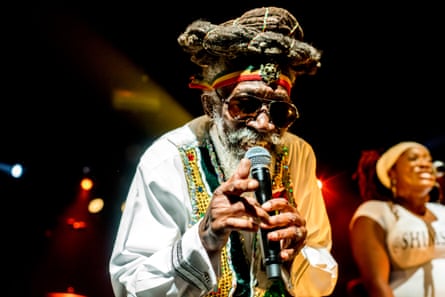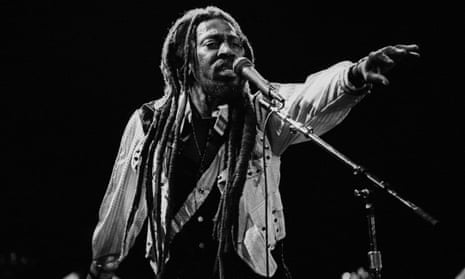As one-third of the Wailers with Bob Marley and Peter Tosh, Bunny Wailer, who has died aged 73 of a stroke, was an integral part of the most influential musical group to have emerged from Jamaica. The least feted of the trio, he was in many ways the most respected, for as each of the Wailers pursued solo careers from the mid-1970s onwards – Marley to become reggae’s global evangelist and Tosh its militant conscience – Wailer continued on his quiet path as its spiritual ambassador. His debut album, Blackheart Man, is widely felt to be one of reggae’s highest peaks.
While Wailer’s initial acclaim stemmed from his work with Marley and Tosh, his later fame was derived from his solo output, which rested heavily, though by no means exclusively, on the masterful Blackheart Man. Released in 1976, just over two years after the Wailers had split, it was a gigantic achievement, simultaneously homespun and polished, uplifting and sorrowful, ethereal and worldly wise – and with an elemental aura about it that was summed up by its dark, foreboding cover, featuring a lion-like representation of its dreadlocked creator.
Wailer was unable to follow up with anything quite so powerful or influential. But while he often spent long periods out of the public eye, tending to his land in the Jamaican countryside, he nevertheless produced a steady stream of ear-catching albums and singles that kept him energised and relevant at least until the early 90s.
He was born Neville Livingston in Kingston, Jamaica, to Thaddeus Livingston, a rum shop proprietor known as Toddy, and his wife, Margaret, but grew up in the same small rural village – Nine Mile – as his childhood friend Marley, with whom he attended an all-age school in the nearby settlement of Stepney. Marley’s mother, Cedella, was a housekeeper for Toddy, and in 1963 she bore him a child, Pearl, who was therefore a sister to both Livingston and Marley. When Livingston’s family moved to the Trench Town area of Kingston, Marley went with them, and for a time he was part of the household. Soon he and Livingston ran into Tosh, who had also moved to the city from the countryside, and, to add to the tangled web, Tosh had a child, Andrew, by Livingston’s sister Shirley.
As impoverished teenagers Tosh, Marley and Livingston (nicknamed Bunny) would sneak into Kingston’s open-air dances to drink in the music of American artists of the late 50s and early 60s. They began to sing together as a harmony group, and by 1964 had released the ska single Simmer Down under the name of the Wailing Wailers. It went straight to No 1 in the Jamaican charts, made a small stir in the UK and allowed them to begin making stage appearances as a rather conventional-looking, if rude-boy sharp, trio. Demonstrating a fierce work ethic, the Wailers went on to produce a string of local hits, including Put It On and Rude Boy. But success in the Jamaican charts was no route to financial comfort, and they continued to live a hand-to-mouth existence.
Some solace came in Livingston’s embrace of the Rastafarian faith, but in the spring of 1967, aged 20, his fortunes worsened dramatically when he was arrested for cannabis possession. Sentenced to 18 months’ hard labour in Kingston’s brutal General Penitentiary, after several months he was transferred to the prison farm, earning privileges through his value to the jail’s cricket team and increasing his intake of marijuana, which was supplied by the wardens.
While Livingston was inside, the other Wailers had begun to work with the eccentric producer Lee “Scratch” Perry, who helped to reinvent their sound and hooked them up with the brothers Carlton and Aston Barrett on drums and bass. After Livingston rejoined them, they recorded two albums, Soul Rebels (1970) and Soul Revolution (1971), their first to be released abroad. But the ever-watchful Livingston had been suspicious of Perry, and the group eventually fell out with the producer over financial matters when both albums were released in the UK. By the end of 1971, after almost a decade of being fleeced by unscrupulous businessmen and producers, they were still poor.
With Perry jettisoned, some financial stability arrived when the Wailers signed to Chris Blackwell’s Island Records, after which they recorded the album Catch a Fire in early 1973, featuring songs such as Stir It Up, Concrete Jungle and Kinky Reggae. A tour followed in the US and UK, where they made a memorable appearance on the Old Grey Whistle Test television show that set them on the path towards international recognition. Another album, Burnin’, came later in 1973, with righteous classics such as Get Up, Stand Up and Small Axe. By then, however, Livingston, who had been unnerved by life on the road and unimpressed by Blackwell’s thrusting of Marley into the spotlight, had decided to leave the group, followed shortly afterwards by Tosh.

Out on his own and adopting the stage name of Bunny Wailer to signpost his connections, Livingston was able to move away from Marley’s shadow and bring his own composing talents to the fore. Aside from its new compositions, Blackheart Man also featured tunes he had written many years before but which had largely been ignored, including Fighting Against Conviction, which he composed in jail. Reimagined in a mystical Rasta vein (with Marley and Tosh on backing vocals), his old songs were given a new life that became the essence of roots reggae.
Livingston followed up with three albums over the next three years – including Protest in 1977 and Struggle in 1978 – and while little of his later output had quite the same meditative vibe as Blackheart Man, he proved himself to be a formidable songwriter, not least through uplifting singles that celebrated the joys of the dancehall, including Rock ’n’ Groove and Cool Runnings, both in 1981. He remained a prolific releaser of material until 1989, when he came up with his last really notable album, Liberation.
Never a lover of travelling, Livingston’s fear of flying restricted his touring, although he did play on occasion in Europe and the US. In later life he mostly contented himself with enjoying the large plot of hilly land 60 miles west of Kingston that he had bought with a cash settlement from Island Records. There he communed with nature, grew corn and smoked herb.
He was awarded the Order of Jamaica in 2012 and a Bunny Wailer museum was opened in Kingston in 2017. In 2020 his wife, Jean Watt, suffering from dementia, disappeared from the family home; her whereabouts remain unknown. He is believed to be survived by 13 children.

Comments (…)
Sign in or create your Guardian account to join the discussion